Skip to content 
The Corgi and the Queen
By Caroline L. Perry, Illustrated by Lydia Corry
Even a monarch needs a best friend and Queen Elizabeth II found one in a corgi pup she named Susan. From princesshood to queendom the pair forged an unbreakable bond, with Susan even participating in Elizabeth’s wedding day and joining her on honeymoon with Prince Philip. Over the course of her remarkable seventy-year reign the Queen had more than thirty corgi companions, and almost all were direct descendants of her cherished Susan. 6-9 years

Little Elizabeth: The Young Princess Who Became Queen
By Valerie Wilding, Illustrated by Pauline Reeves
The incredible true story of a young and brilliant Princess who grew up to become our Queen. Once, a very long time ago, there was a little Princess called Elizabeth (or Lilibet as her family liked to call her) who loved to play and have fun with her horses, dogs and little sister, Margaret. But when she was ten years old, her life changed forever.
From growing up during the Second World War and training as an army mechanic, to celebrating VE day with the people of Britain and marrying Prince Phillip, The Duke of Edinburgh – the man she truly loved – this is the amazing true story of a little girl who became Queen Elizabeth II. 6-8 years
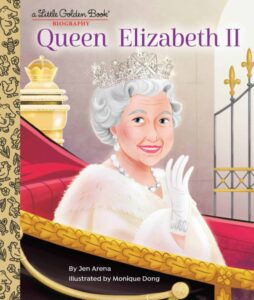
Queen Elizabeth II: A Little Golden Book Biography
By Jen Arena, Illustrated by Monique Dong
Help your little one dream big with a Little Golden Book biography about Queen Elizabeth II! The perfect introduction to nonfiction for preschoolers! This Little Golden Book about Queen Elizabeth II who sat on the throne for more than 70 years and was the longest ruling monarch of the United Kingdom is an inspiring read-aloud for young girls and boys. 4 years+

Queen Elizabeth: The Queen Who Chose to Serve
By Alison Mitchell, Illustrated by Emma Randall
Princess Elizabeth never expected to be Queen. But when she was ten, her uncle, King Edward VIII, abdicated and everything changed… Her father took over as King, but after 15 years on the throne, he died. So when she was just 25 years old, Elizabeth was crowned Queen and became the longest-serving monarch in British history.
This children’s biography of Queen Elizabeth II (1926-2022) chronicles key moments in her life. It also highlights her Christian faith, in particular what she has said in her Christmas Day speeches. 4-7 years
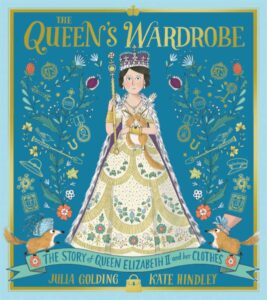
The Queen’s Wardrobe: The Story of Queen Elizabeth’s Clothes
By Julie Golding, Illustrated by Kate Hindley
The story of Queen Elizabeth II, who famously said ‘if I wore beige, no one would know who I was’, told through her clothes and jewelry. The Queen’s Wardrobe is a gorgeous gift to treasure, celebrating a long life devoted to service.
This book tells the story of a young princess who grew into one of the world’s best-loved and longest-serving royals, touching on wartime truck-fixing, ration-book wedding dress making, splendid gowns, the Crown Jewels, and her trusty wellies. 7-11 years

Our Queen Elizabeth: Her Extraordinary Life from the Crown to the Corgis
By Kate Williams
Discover everything there is to know about the life and the legacy of Queen Elizabeth II in this illustrated book. Readers will learn all about Elizabeth II’s youth growing up during the Second World War, how she came to the throne and what it really means to be the Queen. Along the way, they’ll see her sparkling crown jewels and magnificent palaces. They will meet her beloved corgis, horses and of course, her very famous family. Plus they’ll discover lots of amazing facts – such as why she has two birthdays, always wears bright clothing, and is a world record breaker! 6-8 years

Her Majesty the Queen Elizabeth II
By David Chung, Illustrated by Farimah Khavarinezhad
Explore the life of Queen Elizabeth II, the longest-reigning British monarch – an introduction for children. In this picture book, you’ll find full-page color illustrations sharing some of the key moments in Queen Elizabeth’s life. Readers will learn about her family and her ascension to the crown as well as her love for corgis. The book also includes fun facts about the queen to share with young readers. 3-6 years

Who Was Queen Elizabeth II
By Megan Stine, Illustrated by Laurie A. Conley
In 1936, the life of ten-year-old Princess Elizabeth of York changed forever. Although she was a member of the British Royal Family, she never expected to become queen. But when her uncle Edward gave up the throne, suddenly her father was the new king, which meant young Elizabeth was next in line!
Queen Elizabeth reigned for seventy years, and while there were palaces galore, the crown jewels, and trips around the world, her life was one of strict discipline and duty. 8-12 years

Queen Elizabeth: A Platinum Jubilee Celebration
By DK Publishing
In honor of Queen Elizabeth’s Platinum Jubilee 2022, this book for kids tells the story of a young princess who grew up to become our longest reigning monarch, and celebrates the achievements, people and places that have become part of her remarkable legacy.
There is a treasure box hidden away in Great Granny Joyce’s home, bursting with all kinds of things… A photo of a young woman wearing a crown, a map of the world, newspaper clippings, and so much more that reveal the great wonders of the last 70 years. Little Isabella doesn’t even know where to begin! Did you know that Princess Elizabeth was only 27 when she became Queen? Or that she made an appearance at the opening ceremony of the 2010 London Olympics alongside James Bond? And that the most astonishing inventions like the World Wide Web, as well as historic milestones like the first female Prime Minister of the UK happened under our Queen’s watch? 5-9 years
The book descriptions are primarily from the publishers.
If you like this post, then please consider sharing it and/or leaving a comment below. Thank you! Barbara Lowell, Children’s Author
You may like:

Stubby: Inspired by the True Story of an American Hero of World War I
By Kathy Borrus, Illustrated by Julia Mills
A heartwarming tale of friendship between an American soldier and his best buddy, a dog. Stubby is the true story of the most heroic dog in World War I. From stray puppy to the only dog ever promoted to the rank of Sergeant and the winner of the Purple Heart, Stubby’s remarkable journey is appropriate for all ages.

Sergeant Stubby: How a Stray Dog and His Best Friend Helped Win World War I and Stole the Heart of a Nation
By Ann Bausum
Meet Sergeant Stubby: World War I dog veteran, decorated war hero, American icon, and above all, man’s best friend. Stubby’s story begins in 1917 when America is about to enter the war. A stowaway dog befriends Private James Robert “Bob” Conroy at the Connecticut National Guard camp at Yale University and the two become inseparable. Stubby also wins over the commanding officer and is soon made an official member of the 102nd Infantry of the 26th division. What follows is an epic tale of how man’s best friend becomes an invaluable soldier on the front lines and in the trenches, a decorated war hero and an inspiration to a country long after the troops returned home.
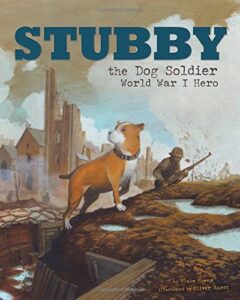
Stubby the Dog Soldier: World War I Hero
By Blake Hoena, Illustrated by Olivia Ian Hurst
A stray dog named Stubby braves the World War I battlefields alongside Private J. Robert Conroy. See the story unfold as this brave little canine makes a big difference in the lives of many World War I soldiers. 5-7 years

Stubby: A True Story of Friendship
By Michael Foreman
Stubby, a brave soldier, a loyal friend… and a dog. From an army training camp to the trenches in France, this is the incredible true story of Sgt. Stubby, the dog who served bravely in the First World War, sniffing out gas attacks, catching spies and winning the hearts of his fellow soldiers. 5-7 years
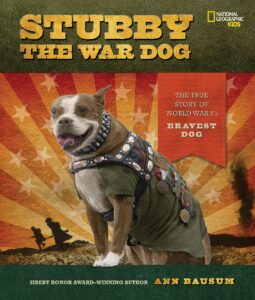
Stubby the War Dog: The True Story of World War I’s Bravest Dog
By Ann Bausum
Move over, Rin Tin Tin. Here comes Sergeant Stubby! That German shepherd star of the silver screen may have been born behind enemy lines during World War I, but Stubby, the stump-tailed terrier, worked behind enemy lines, and gained military honors along the way.
Private Robert Conroy casually adopted the orphan pup while attending basic training on the campus of Yale University in 1917. The Connecticut volunteer never imagined that his stray dog would become a war hero. He just liked the little guy. When Conroy’s unit shipped out for France, he smuggled his new friend aboard. By the time Stubby encountered Conroy’s commanding officer, the dog had perfected his right-paw salute. Charmed, the CO awarded Stubby mascot status and sent him along with Conroy’s unit to the Western Front.
Stubby’s brave deeds earned him a place in history and in the Smithsonian Institution where his stuffed body can still be seen. Almost 100 years later, Stubby’s great deeds and brave heart make him an animal hero to fall in love with and treasure all over again. 10-14 years

G.I. Dog: Sergeant Stubby Hero Pup of World War I
By Laurie Calkhoven
Meet Stubby: a stray pup who was taken in by a group of American soldiers-in-training and soon found himself whisked off to the front lines of World War I as the official mascot of the 102nd Infantry Regiment. Stubby served bravely by his soldiers’ sides for 18 months and became a hero when he saved his regiment from a surprise gas attack. And he singlehandedly caught an enemy German soldier in No Man’s Land.
Join Stubby on his incredible journey from puppy to soldier to high-ranking sergeant as he narrates his story of heroism. This “dog’s-eye view” takes readers into the heart of the action of WWI and will leave them cheering for Stubby and his human companions as they overcome countless obstacles and prove time and again why a dog really is man’s best friend. 7-10 years
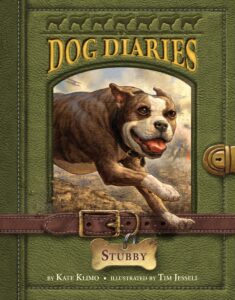
Dog Diaries #7: Stubby
By Kate Klimo, Illustrated by Tim Jessell
Stubby the war dog narrates the story of his life–from his days as a stray to his time on the battlefields of France! Adopted by Private John Robert Conroy in 1917 when the dog wandered into training camp, Stubby soon became the mascot for the 26th Yankee division–even learning how to salute. When the men were shipped out for France, Conroy smuggled Stubby on-board. The rest is the kind of incredible true story that dog-crazy middle graders love. By the end of the war, Stubby had served in 17 battles, been injured by mustard gas and a grenade; found and captured a German spy; shaken hands with Woodrow Wilson; and become the first dog given rank in the United States Armed Forces! 7-10 years

Why Did Sergeant Stubby Go to War?
By Cathy Werling, Illustrated by Christina Garcia
Stubby, a homeless dog who could have been left for lost saved countless lives in World War I. He became the most decorated animal in American military history. Stubby, a mix of Boston terrier and pit bull, was discovered, rescued, and taught by Private Robert Conroy and his colleagues, who were training for World War I at Yale University in 1917. Conroy smuggled Stubby aboard a transport ship to Europe with the U.S. 102nd Infantry, 26th Yankee Division. His commanding officer discovered the dog several days later and was quite displeased–until Stubby saluted the officer with his paw as the soldiers had trained him to do.
In the trench warfare of Europe, Stubby would bark to alert the regiment of surprise mustard gas attacks and incoming artillery fire, giving the soldiers time to grab their gas masks or hit the bottom of the trenches before a raid. Trained to differentiate between German and English speakers, Stubby would also locate wounded English-speaking soldiers in the trenches and bark until paramedics arrived. He even once caught a German spy.
Stubby braved through 17 WWI battles, saving countless Allied soldiers’ lives through his actions. For his courage, he received many military honors and marched in the Victory Parade. 5-11 years
The book descriptions are primarily from the publishers.
If you like this post, then please consider sharing it and/or leaving a comment below. Thank you! Barbara Lowell, Children’s Author
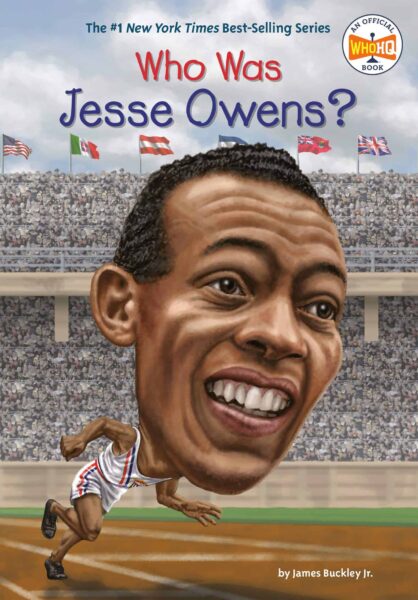
Who Was Jesse Owens
By James Buckley, Jr., Illustrated by Gregory Copeland
At the 1936 Berlin Summer Olympics, track and field star Jesse Owens ran himself straight into international glory by winning four gold medals. But the life of Jesse Owens is much more than a sports story.
Born in rural Alabama under the oppressive Jim Crow laws, Owens’s family suffered many hardships. As a boy he worked several jobs: delivering groceries and working in a shoe repair shop to make ends meet. Owens defied the odds to become a sensational student athlete, eventually running track for Ohio State. He was chosen to compete in the Summer Olympics in Nazi Germany where Adolf Hitler was promoting the idea of “Aryan superiority.” Owens’s winning streak at the games humiliated Hitler and crushed the myth of racial supremacy once and for all. 8-12 years

Jesse Owens: Fastest Man Alive
By Carole Boston Weatherford, Illustrated by Eric Velasquez
Jesse Owens grew up during the time of Jim Crow laws, but adversity didn’t stop him. After setting world records for track in high school and college, he won a slot on the 1936 U.S. Olympic team. That year, the Olympics were held in Nazi Germany, where Adolf Hitler believes the Games would prove to the world that people like him were superior to all others. But Jesse, a sharecropper’s son, would ultimately topple Hitler’s hopes, winning four gold medals and the hearts of millions to become known as the fastest man alive. 7-11 years
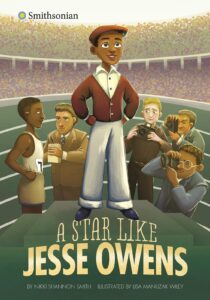
A Star Like Jesse Owens
By Nikki Shannon Smith, Illustrated by Lisa Manuzak Wiley
Matthew is a young African-American boy who dreams of becoming an Olympic runner like his hero, Jesse Owens. There’s one big problem, though Matthew has asthma, which makes it hard for him to run. When his journalist father is assigned to cover the 1936 Olympics in Germany, Matthew jumps at the chance tag along. He has never been out of Ohio before, let alone to Europe. Will Owens’s amazing Olympic victories inspire Matthew in his own chosen career? 8-11 years
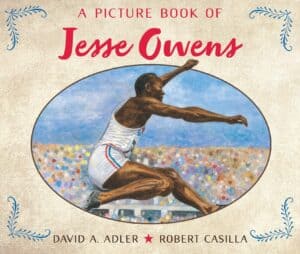
A Picture Book of Jesse Owens
By David A. Adler, Illustrated by Robert Casilla
Before Usain Bolt or Tyson Gay, Bob Beamon or Carl Lewis, Jesse Owens was perhaps the greatest and most famous athlete in track and field history.
Jesse Owens was born on a farm to a large family with many siblings. His grandparents had been slaves, and his sharecropper parents were poor. But against all odds, Jesse went on to become one of the greatest athletes in history. He learned to run with such grace that people said he was a “floating wonder.”
After setting multiple world records as a college athlete, including three in less than an hour—”the greatest 45 minutes in sport”—Owens competed in the 1936 Olympics in Berlin. Adolf Hitler intended for the games to display Aryan superiority, but Jesse disrupted that plan. He became the first American track-and-field athlete to receive four Olympic gold medals and established his legacy as a hero in the face of prejudice. 4-8 years

Just Like Jesse Owens
By Andrew Young and Paul Young Shelton Illustrated by Gordon C. James
As a boy, Andrew Young learned a vital lesson from his parents when a local chapter of the Nazi party instigated racial unrest in their hometown of New Orleans in the 1930s. While Hitler’s teachings promoted White supremacy, Andrew’s father, told him that when dealing with the sickness of racism, “Don’t get mad, get smart.” To drive home this idea, Andrew Young Senior took his family to the local movie house to see a newsreel of track star Jesse Owens racing toward Olympic gold, showing the world that the best way to promote equality is to focus on the finish line. The teaching of his parents, and Jesse Owens’ example, would be the guiding principles that shaped Andrew’s beliefs in nonviolence and built his foundation as a civil rights leader and advisor to Dr. Martin Luther King, Jr. The story is recalled by Paula Young Shelton, Andrew’s daughter. 6-8 years
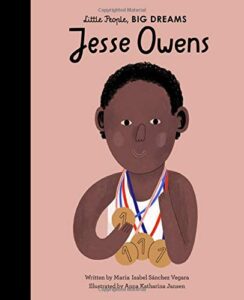
Jesse Owens (Little People, Big Dreams)
By Maria Isabel Sanchez Vegara, Illustrated by Anna Katharina Jansen
The youngest of ten children, Jesse grew up working in the cotton fields of Alabama. Discovered by his high school track and field coach, Jesse quickly rose to fame as an athlete. He went on to challenge racism on the world stage at the 1936 Berlin Olympics and made new world records. This book features extra facts at the back, including a biographical timeline with historical photos and a detailed profile of the athlete and activist’s life. 4-7 years
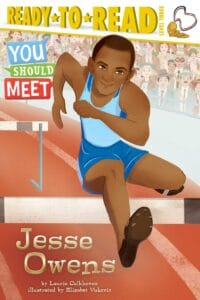
Jesse Owens (You Should Meet)
By Laurie Calkhoven, Illustrated by Elizabeth Vukovic
Meet Jesse Owens, an African American runner who won four gold medals at the 1936 Olympics in Berlin! What made his achievement even more memorable was that Adolph Hitler expected the Olympic Games to be a German showcase. In fact, he criticized the United States for even including black athletes on its Olympic roster. According to many reports, after Owens won his fourth gold medal, Hitler stormed out of the stadium. In 1936 Jesse Owens took a stand against racism and made history.
A special section at the back of the book includes extras on subjects like history and math, plus an article filled with interesting facts about the Olympics. 6-8 years

Defying Hitler: Jesse Owens Olympic Trials
By Nel Yomtov, Illustrated by Eduardo Garcia
At the 1936 Summer Olympics in Berlin, Germany, the last thing Adolf Hitler expected was to see a black man compete and win. But Jesse Owens didn’t just win. He was dominant in the track and field events, winning four gold medals and helping to set a world record. Now readers can witness one of the most iconic moments in sports history. 8 and up
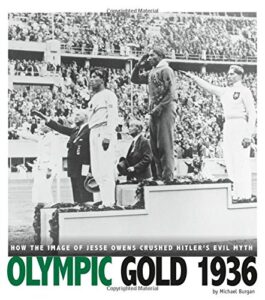
Olympic Gold 1936:
How the Image of Jesse Owens Crushed Hitler’s Evil Myth
By Michael Burgan
Jesse Owens’ gold-medal winning feats at the 1936 Olympics in Berlin struck a mighty propaganda blow against Adolf Hitler. The Nazi leader had planned to use the German games as a showcase for supposed Aryan superiority. Instead, there was American black athlete Owens on the podium being photographed by Hitler’s personal photographer, Heinrich Hoffmann. In addition, Owens would figure prominently in the groundbreaking film Olympia by Hitler’s favorite director Leni Riefenstahl. Photos and film captured Owens’ stunning success and revealed how wrong Hitler was in his beliefs. 10-12 years
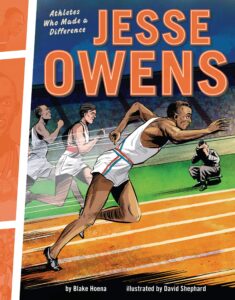
Jesse Owens: Athletes Who Made a Difference
By Blake Hoena, Illustrated by David Shephard
In 1936, Adolf Hitler attempted to make the Olympic Games in Berlin, Germany, a showcase of Nazi superiority with a new stadium and the first television broadcast of the Games. He didn’t account for African-American sprinter and long jumper James Cleveland “Jesse” Owens, who smashed records throughout his track and field career.
Owens turned Hitler’s Olympic vision on its head by winning four gold medals in the 100m, 200m, 4x100m relay and long jump. Along the way, he broke or equaled nine Olympic records and set three world records. In graphic nonfiction style, this biography takes readers from Owens’s early life to his historic athletic triumphs. 8-12 years

Jesse Owens: Amazing People Who Shaped the World
By James Buckley, Jr.
Jesse Owens is one of the most famous athletes of all time, winning an incredible four gold medals at the 1936 Olympic Games. But he faced discrimination throughout his athletic career.
This biography charts the major events of Jesse’s life; from his childhood growing up on a farm in Alabama, to his family’s move to Ohio in search of better opportunities, to the beginning of his running career and his years as a world record-breaking student athlete, all the way to the Olympics and beyond. 8-11 years
The book descriptions used are primarily from the publishers.
If you like this post, then please consider sharing it and/or leaving a comment below. Barbara Lowell, Children’s Author
You may like:
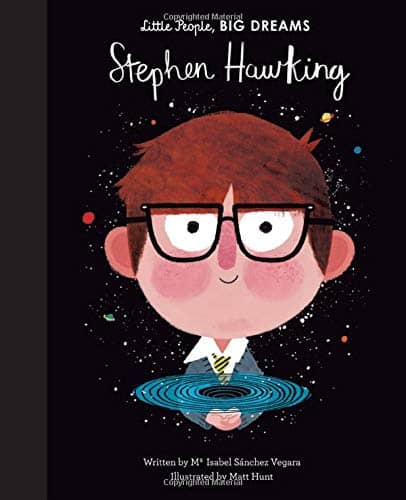
Stephen Hawking
By Maria Isabel Sanchez Vegara
When Stephen Hawking was a little boy, he used to stare up at the stars and wonder about the universe. Although he was never top of the class, his curiosity took him to the best universities in England, Oxford and Cambridge. It also led him to make one of the biggest scientific discoveries of the 20th century, Hawking radiation. This book features stylish and quirky illustrations and extra facts at the back, including a biographical timeline with historical photos and a detailed profile of the brilliant physicist’s life. 4-7 years

Stay Curious: A Brief History of Stephen Hawking
By Kathleen Krull, Illustrated by Paul Brewer
As a young boy, Stephen Hawking loved to read, stargaze, and figure out how things worked. He looked at the world and always asked, Why?
He never lost that curiosity, which led him to make groundbreaking discoveries about the universe as a young man. Even being diagnosed with ALS didn’t slow Stephen down. Those questions kept coming. As his body weakened, Stephen’s mind expanded allowing him to unlock secrets of the universe and become one of the most famous scientists of all time.
Stephen always approached life with courage, a sense of humor, and endless curiosity. His story will encourage readers to look at the world around them with new eyes. 4-8 years

Who Was Stephen Hawking?
By Jim Gigliotti, Illustrated by Gregory Copeland
Stephen Hawking was born exactly three hundred years after the death of the scientist Galileo, so maybe it was written in the stars that he would become a famous scientist in his own right. Although he was diagnosed with a neurological disease at age 21, Stephen did not let the illness define his life.
Known for his groundbreaking work in physics, and identified by his wheelchair and computerized voice system, Stephen continued his research until his death in 2018. He is best known for his black hole theories and his best-selling book A Brief History of Time. Stephen Hawking is an example of a person who had a great mind, but an even greater spirit. 8-12 years
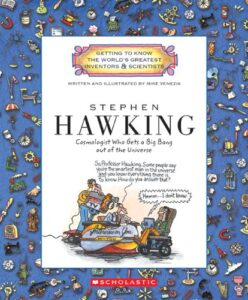
Stephen Hawking: Cosmologist Who Gets a Big Bang Out of the Universe
By Mike Venezia
Meet renowned physicist Stephen Hawking. This book presents the life and work of the British physicist who overcame the challenges of ALS to become one of the foremost scientists of the twentieth century.
This book combines a mix of historical reproductions, photos, and cartoon-style illustrations that bring to life Stephen Hawking’s work and contributions. 6-10 years

All About Stephen Hawking
By Chris Edwards, Illustrated by Amber Calderon
As an Oxford student, Stephen Hawking never expected that people across the world would know his name, or that his hobby of stargazing would lead him to be one of the world’s greatest scientists. Stephen Hawking made cosmology, or the study of the universe, accessible to everyone.
He was diagnosed with amyotrophic lateral sclerosis (ALS) at the age of twenty-one, but didn’t let that stop him from receiving a graduate degree from Cambridge and going on to be an expert in the scientific origin of the universe and black holes. Hawking is best known for writing A Brief History of Time, which explained cosmology in non-scientific terms so that non-scientists could understand it. 10-12 years

The Living Einstein: The Stephen Hawking Story
By Dissected Lives
Despite his debilitating illness, Stephen Hawking found ways to share his knowledge of the universe. He was a bright man who was always hungry for knowledge. He experimented, studied and explored anything and everything from the physical world to the cosmos. Be inspired by his story. Learn from his discoveries. 8-12 years

Stephen Hawking: A Life Beyond Limits
By Alex Woolf
In 1974, Stephen Hawking shook the world of physics. His theory on black holes went against everything the science community accepted as fact. How did he make such revolutionary discoveries? From a childhood spent building model airplanes to recognition as one of the greatest scientists of his time, Stephen’s genius and endless curiosity powered his work. Find out how this boy who loved science became one of history’s greatest trailblazers! 8-13 years
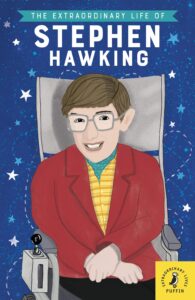
The Extraordinary Life of Stephen Hawking
By Kate Scott, Illustrating by Ester Mols
Stephen Hawking was: a physicist, a cosmologist, an author and one of the cleverest people who ever lived. While studying at Oxford University, Stephen Hawking was diagnosed with motor neurone disease, which meant that eventually he was completely paralyzed, and could only talk via a computer.
But that never held him back, and because of his work on time and space, he changed the way the world thinks about the universe.
Discover more about the life of a man who is known for his incredible contribution to science. 7-12 years

Little Guides to Great Lives: Stephen Hawkings
By Isabel Thomas, Illustrated by Marianna Madiz
Stephen Hawking was one of the world’s most renowned scientists and cosmologists. His ground–breaking research into black holes and the Big Bang has helped to explain the beginnings of our universe and his book A Brief History of Time has sold over 10 million copies. Diagnosed with a form of motor neuron disease when he was a young man, Stephen was inspired to achieve his goals as fast as possible. Through incredible determination and skill, he became a legendary scientist, a best–selling author, and the man that changed the way we think about the universe.
The book descriptions used are primarily from the publishers.
If you like this post, then please consider sharing it and/or leaving a comment below. Thank you! Barbara Lowell, Children’s Author

BEHIND THE BOOKCASE: MIEP GIES, ANNE FRANK AND THE HIDING PLACE
By Barbara Lowell, Illustrated by Valentina Toro
Miep Gies risked her life to keep a secret. Behind the bookcase in her office, stairs led to a hiding place where Anne Frank and her family hid from the Nazis. Once a refugee herself, Miep knew the power of kindness. Her selflessness, humanity, and bravery sheltered Anne for a time. Because of Miep, Anne Frank’s story lives on. –Behind the Bookcase Jacket
YOUNG MIEP GIES
Miep Gies was born in Vienna, Austria, in 1909. Her name was Hermine Santrouschitz. After Austria’s loss in World War I, food was scarce and Miep became malnourished as many of Austria’s children did. Her parents were concerned that their eleven-year-old daughter might die.
Along with other families in the Netherlands, the Nieuwenhuises offered to take care of an Austrian child. Miep’s parents sent her to Leiden to live with the Dutch family. They called her Hermine at first, but then gave her the “affectionate Dutch nickname” Miep. Soon, Mr. and Mrs. Neiuwenhuise began to think of Miep as their adoptive child and the four boys in the family referred to her as one of their two sisters.
Through their kindness and lots of Dutch bread, butter, milk, cheese and chocolate, Miep grew healthy. Her foster father took her to school where the children grabbed her hands, sat her down, and taught her to speak Dutch. Soon, Miep was the top student in her class.
Miep embraced the Dutch life. She rode a bicycle for the first time, learned to make butter sandwiches, talked about what she read in the newspaper and learned to love classical music. But ice skating on a frozen canal was something she tried once but would never try again.
When she was thirteen, Miep and her new family moved to Amsterdam. She loved its movie theaters, electric streetcars, the canals winding through the city, the beautiful flower stalls, and all the bicycles racing along the city’s bike paths.
When she was sixteen, she visited her Austrian family. Miep told them that she had grown to love living in Amsterdam and wanted to stay there. She considered herself to be Dutch now. Her parents gave their permission and Miep returned to Amsterdam and her life with the Nieuwenhuise family. In 1941, she married Jan Gies. From the time she was eleven until her death in 2010, at age 100, Miep Gies lived a proud Dutch life.
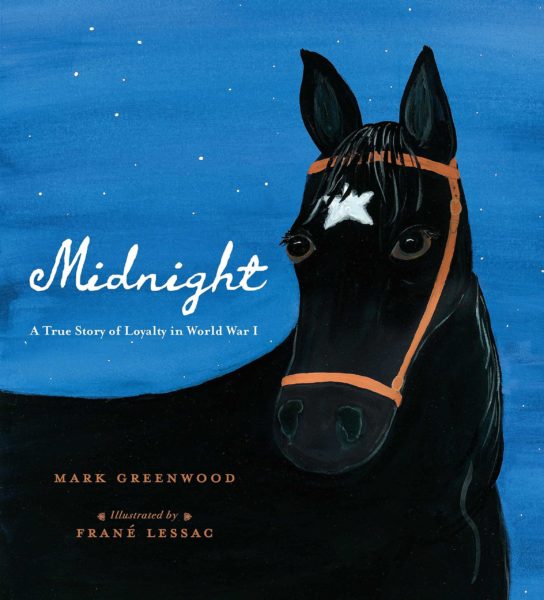
Midnight: A True Story of Loyalty in World War I
By Mark Greenwood, Illustrated By Frané Lessac
Guy Haydon raised and trained Midnight from the time she was a foal. The two had such a strong bond that when World War I broke out, Lieutenant Haydon slipped away from the frontlines of Gallipoli on an Egypt-bound ship to reunite with his horse. There, in the city of Beersheba, on October 31, 1917, two regiments of the Australian Light Horse Brigade took part in one of the last great cavalry charges in history. Among the first to leap the enemy trenches was Lieutenant Guy Haydon, riding Midnight—who succumbed to a bullet that might have otherwise killed her rider. In a new story from an award-winning duo, luminous illustrations and lyrical narration bring a sad moment in history to life. 5-9 years

Winnie’s Great War
by Lindsay Mattick and Josh Greenhut, Illustrated by Sophie Blackall
Here is a heartwarming imagining of the real journey undertaken by the extraordinary bear who inspired Winnie-the-Pooh. From her early days with her mama in the Canadian forest, to her remarkable travels with the Veterinary Corps across the country and overseas, and all the way to the London Zoo where she met Christopher Robin Milne (and inspired the creation of the world’s most famous bear,) Winnie is on a great war adventure.
This story is a blending of deep research and magnificent imagination. Infused with Sophie Blackall’s renderings of an endearing bear, the book is also woven through with entries from Captain Harry Colebourn’s real wartime diaries and contains a selection of artifacts from the Colebourn Family Archives. The result is a one-of-a-kind exploration into the realities of war, the meaning of courage, and the indelible power of friendship, all told through the historic adventures of one extraordinary bear. 8-11 years
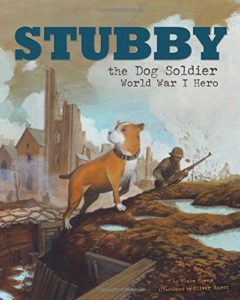
Stubby The Dog Soldier: World War I Hero
By Blake Hoena, Illustrated by Oliver Ian Hurst
A stray dog named Stubby braves the World War I battlefields alongside Private J. Robert Conroy. See the story unfold as this brave little canine makes a big difference in the lives of many World War I soldiers. 5-7 years
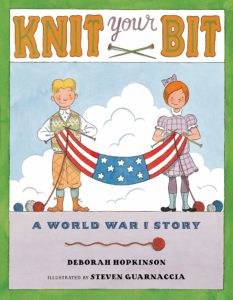
Knit Your Bit! A World War I Story
By Deborah Hopkinson, Illustrated by Steven Guarnaccia
Mikey’s dad has left home to fight overseas during World War I, and Mikey wants to do something BIG to help. When his teacher suggests that the class participate in a knitting bee in Central Park to knit clothing for the troops, Mikey and his friends roll their eyes—knitting is for girls! But when the girls turn it into a competition, the boys just have to meet the challenge.
Based on a real “Knit-In” event at Central Park in 1918, Knit Your Bit shows readers that making a lasting contribution is as easy as trying something new! 5-8 years

Stubby the War Dog: The True Story of World War I’s Most Famous Dog
By Ann Bausum
Move over, Rin Tin Tin. Here comes Sgt. Stubby! That German shepherd, Rin Tin Tin, star of the silver screen may have been born behind enemy lines during World War I, but Stubby, the stump-tailed terrier, worked behind enemy lines, and gained military honors along the way.
Private Robert Conroy casually adopted the orphan pup while attending basic training on the campus of Yale University in 1917. The Connecticut volunteer never imagined that his stray dog would become a war hero. He just liked the little guy. When Conroy’s unit shipped out for France, he smuggled his new friend aboard. By the time Stubby encountered Conroy’s commanding officer, the dog had perfected his right-paw salute. Charmed, the CO awarded Stubby mascot status and sent him along with Conroy’s unit to the Western Front. 10-13 years
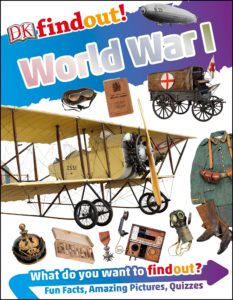
DK Findout! World War I
By Brian Williams
Did you know that the Allied powers used 33,000 camels in desert warfare? Or that more than 500,000 pigeons carried messages to the war’s front lines? Find out why!
Perfect for young history buffs and fans of the Axis & Allies board games, DK findout! World War I is a highly visual world-history book sure to inspire the next amazing school project or report. Inside, author Brian Williams breaks down why the war began, how it was fought, and what brought it to an end. 6-9 years
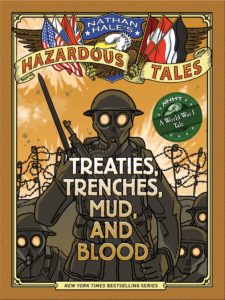
Treaties, Trenches, Mud, and Blood
By Nathan Hale
World War I set the tone for the 20th century and introduced a new type of warfare: global, mechanical, and brutal. Nathan Hale has gathered some of the most fascinating true-life tales from the war and given them his inimitable Hazardous Tales twist. Easy to understand, funny, informative, and lively, this series is the best way to be introduced to some of the most well-known battles (and little-known secrets) of the infamous war. 8-12

Dazzle Ships: World War I and the Art of Confusion
By Chris Barton, Illustrated by Victo Ngai
During World War I, British and American ships were painted with bold colors and crazy patterns from bow to stern. Why would anyone put such eye-catching designs on ships?
Desperate to protect ships from German torpedo attacks, British lieutenant-commander Norman Wilkinson proposed what became known as dazzle. These stunning patterns and colors were meant to confuse the enemy about a ship’s speed and direction. By the end of the war, more than four thousand ships had been painted with these mesmerizing designs.
Author Chris Barton and illustrator Victo Ngai bring to life this little-known story of how the unlikely and the improbable became just plain dazzling. 7-11 years

Where Poppies Grow: A World War I Companion
By Linda Granfield
When World War I began in 1914, no one knew that millions of young people would die in the agonizing years ahead. No one imagined the effect it would have on family life, or that whole villages would disappear, or that entire nations would be changed forever. They believed their sons and daughters, mothers and fathers would be home by Christmas. They were tragically mistaken.
With photos, memorabilia, and anecdotes, Linda Granfield brings us face-to-face with people from all walks of life who risked everything for their country. These painstakingly-gathered bits and pieces are remnants of conflict on a scale never before witnessed. Hastily-penned letters, notes written in code, and prayers for deliverance form an eloquent portrait of humanity, and a startling comment on the devastation of war. 11 and up

World War I For Kids: A History with 21 Activities
By R. Kent Rasmussen
One hundred years after the start of the “Great War,” World War I for Kids provides an intriguing and comprehensive look at this defining conflict that involved all of the world’s superpowers. Why and how did the war come about? What was daily life like for soldiers in the trenches? What roles did zeppelins, barbed wire, and the passenger ship Lusitania play in the war? Who were Kaiser Wilhelm, the Red Baron, and Edith Cavell? Young history buffs will learn the answers these questions and many others, including why the western front bogged down into a long stalemate; how the war ushered in an era of rapid military, technological, and societal advances; and how the United States’ entry helped end the war.
Far from a dry catalog of names, dates, and battles, this richly illustrated book goes in depth into such fascinating topics as turn-of-the-20th-century weaponry and the important roles animals played in the war, and explains connections among events and how the war changed the course of history. Hands-on activities illuminate both the war and the times.
Kids can: Make a periscope, teach a dog to carry messages, make a parachute, learn a popular World War I song, cook Maconochie Stew and much more. 9 and up
The book descriptions used are primarily from the publishers.
If you like this post, then please consider sharing it and/or leaving a comment below. Thank you! Barbara Lowell, Children’s Author!
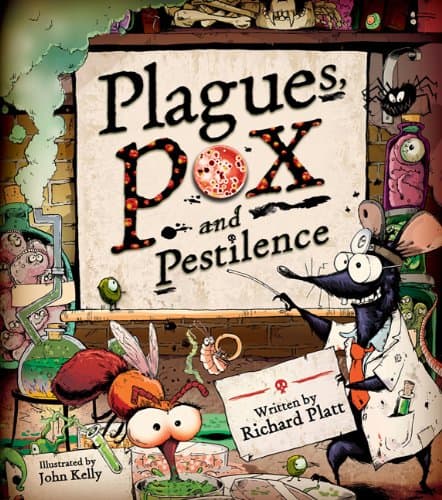
Plagues, Pox, and Pestilence
By Richard Platt , Illustrated by John Kelly
Plagues, Pox, and Pestilence is a history of disease, and pestilence, told from the point of view of the bugs and pests that cause them. This book features case histories of epidemics and eyewitness accounts from the rats, flies, ticks and creepy-crawlies who spread diseases. There are lots of fascinating facts and figures on the biggest and worst afflictions. 7-12 years

Outbreak! Plagues That Changed History
By Bryn Barnard
Filled with fascinating, often gory details about disease and history, Outbreak! is the combination of science and history.
Did the Black Death destroy medieval Europe? Did cholera pave the way for modern Manhattan? Did yellow fever help end the slave trade? Remarkably, the answer to all of these questions is yes. Time and again, diseases have impacted the course of human history in surprisingly powerful ways. Bryn Barnard describes the symptoms and paths of the world’s worst diseases—and how the epidemics they spawned have changed history forever. 8-12 years

Epidemic, Pandemic, Should I Call the Medic?
By Baby Professor
What is the difference between epidemics and pandemics? Learn the difference and more in this biology book for kids. 6 and up
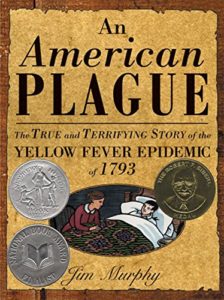
An American Plague:
The True and Terrifying Story of the Yellow Fever Epidemic of 1793
By Jim Murphy
In 1793, Philadelphia was the nation’s capital and the largest city in North America. It’s devastated by an apparently incurable disease, its cause unknown.
Jim Murphy describes the illness known as yellow fever. It took a toll on the city’s residents. He relates the epidemic to the major social and political events of the day and to 18th-century medical beliefs and practices. Drawing on first-hand accounts, he spotlights the heroic role of Philadelphia’s free blacks in combating the epidemic. And the Constitutional crisis that President Washington faced when he was forced to leave the city while escaping the deadly contagion. The search for the fever’s causes and cure, not found for more than a century afterward, provides a suspenseful counterpoint to this story of a city under siege. 10-12 years

Terrible Typhoid Mary: A True Story of the Deadliest Cook in America
By Susan Campbell Bartoletti
What happens when a person’s reputation has been forever damaged? With archival photographs and text among other primary sources, this biography of Mary Mallon looks beyond the tabloid scandal of Mary’s controversial life. How she was treated by medical and legal officials reveals a lesser-known story of human and constitutional rights. It’s entangled with the science of pathology and the enduring questions about who Mary Mallon really was. How did her name become synonymous with deadly disease? And who is really responsible for the lasting legacy of Typhoid Mary? This exploration includes an author’s note, timeline, annotated source notes, and bibliography. 12 and up
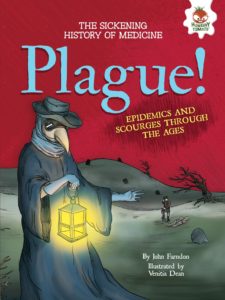
Plague! Epidemics, and Scourges Through the Ages
By John Farndon, Illustrated by Venitia Dean
Being sick is horrible. But it used to be worse. Inside this book, you’ll see evidence of the plagues of the past―rotting skin, dissolving lungs, and sinister swelling all over the body. Diseases like the Black Death wiped out whole towns and villages. Tuberculosis consumed young people like a bloodsucking vampire. And Smallpox left its victims scarred for life―if they survived. At the time, no one knew where these killer diseases came from or how to treat them. But eventually doctors discovered how these diseases and others were spread. Being sick isn’t quite as sickening as it was in the past! 8-12 years

Purple Death
By David Getz
The Spanish Flu was one of the worst epidemics in this country’s history, and the search for its cause is still one of science’s most urgent quests. David Getz tells young readers the story of the mysterious flu known as the Purple Death―the virus responsible for the worst epidemic in American history.
It was 1918, the last year of World War I. Thousands of men lived in crowded army training camps that were scattered all across the United States. That spring, a strange flu struck the soldiers at a camp in the Midwest. Healthy young men went to the hospital complaining of sore throats and fevers. Within hours they had suffocated, their skin taking on a terrible purplish hue.
The devastating flu spread like wildfire across the country, infecting soldiers and civilians alike. It killed more than half a million people in a matter of months, then disappeared as suddenly as it had come.
To this day, no one knows what caused a common flu to become so deadly, but scientists are still searching for answers. What they discover could save millions of lives if another common flu virus suddenly turns into a killer. 7-10 years

Fever 1793
By Laurie Halse Anderson
An epidemic of fever sweeps through the streets of Philadelphia.
During the summer of 1793, Mattie Cook lives above the family coffee shop with her widowed mother and grandfather. Mattie spends her days avoiding chores and making plans to turn the family business into the finest Philadelphia has ever seen. But then the fever breaks out.
The epidemic sweeps the streets, destroying everything in its path and turning Mattie’s world upside down. At her feverish mother’s insistence, Mattie flees the city with her grandfather. But she soon discovers that the sickness is everywhere, and Mattie must learn quickly how to survive in a city turned frantic with disease.
The book descriptions used are primarily from the publishers.
If you like this post, then please consider sharing it and/or leaving a comment below. Thank you! Barbara Lowell, Children’s Author
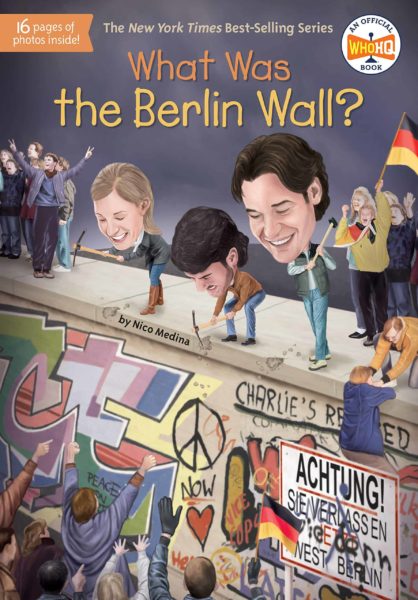
What Was the Berlin Wall?
By Nico Medina, Illustrated by Stephen Marchesi
The Berlin Wall finally came down in 1989. Now readers can find out why it was built in the first place; and what it meant for Berliners living on either side of it. Here’s the fascinating story of a city divided.
In 1961, overnight, a concrete border went up, dividing the city of Berlin into two parts – East and West. The story of the Berlin Wall holds up a mirror to post-WWII politics and the Cold War Era when the United States and the USSR were enemies, always on the verge of war. The wall meant that no one from Communist East Berlin could travel to West Berlin, a free, democratic area. Of course, that didn’t stop thousands from trying to breech the wall – more than one hundred of them dying in the attempt. (One East Berliner actually ziplined to freedom!) Author Nico Medina explains the spy-vs-spy politics of the time as well as what has happened since the removal of one of the most divisive landmarks in modern history. 8-12 years
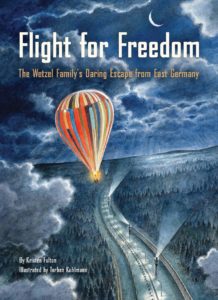
Flight for Freedom:
The Wetzel Family’s Daring Escape from East Germany
By Kristen Fulton, Illustrated by Torben Kuhlmann
An Inspiring True Story about One Family’s Escape from Behind the Berlin Wall!
Peter was born on the east side of Germany, the side that wasn’t free. He watches news programs rather than cartoons, and wears scratchy uniforms instead of blue jeans. His family endures long lines and early curfews. But Peter knows it won’t always be this way. Peter and his family have a secret. Late at night in their attic, they are piecing together a hot air balloon—and a plan. Can Peter and his family fly their way to freedom? This is the true story of one child, Peter Wetzel, and his family, as they risk their lives for the hope of freedom in a daring escape from East Germany via a handmade hot air balloon in 1979. 5-8 years Will be released on March 3, 2020

Cloud and Wallfish
By Anne Nesbet
One ordinary day, Noah’s parents tell him his name isn’t really Noah, his birthday isn’t really in March, and his new home is going to be East Berlin — on the other side of the Iron Curtain. East Germany seems the least likely place in the world for a kid from America with a lot of secrets of his own (and an Astonishing Stutter) to make a friend, but then Noah meets Cloud-Claudia, the lonely girl who lives one floor down. Noah and Cloud-Claudia have only a half-imaginary map and a shared fondness for codes and puzzles to guide them in a world where walls — and the Wall — are closing in. 10-14 years
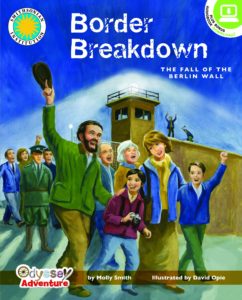
Border Breakdown: The Fall of the Berlin Wall
By Molly Smith, Illustrated by David Opie
Transport back in time to the fall of the Berlin Wall! Children follow Lucy as one moment she is at the National Museum of American History examining pieces of the Berlin Wall, and the next moment, she travels in time to East Berlin during November 1989. Lucy encounters families torn apart, secret police and armed guards as well as the realization that freedom is not something to be taken for granted. Border Breakdown: The Fall of the Berlin Wall offers children an adventurous story that teaches them all about the historic fall and border crossing. A glossary and additional information about the fall of the Berlin Wall is also included to extend the learning fun. 7 and up

A Night Divided
By Jennifer A. Nielsen
With the rise of the Berlin Wall, Greta finds her family suddenly divided. She, her mother and brother Fritz live on the Eastern side controlled by the Soviets. Her father and middle brother who had gone west in search of work cannot return home. Greta knows it is dangerous to watch the wall, yet she can’t help herself. She sees the East German soldiers with their guns trained on their own citizens, as she, her family, her neighbors, are prisoners in their own city.
But one day on her way to school, she spots her father on a viewing platform on the western side pantomiming a peculiar dance. Greta concludes that her father wants her and her brother Fritz to tunnel beneath the wall, out of East Berlin. If they are caught, the consequences will be deadly. No one can be trusted. Will Greta and her family find their way to freedom? 8-12 years

The Other Side of the Wall
By Simon Schwartz
Simon Schwartz was born in 1982 in East Germany, at a time when the repressive Socialist Unity Party of Germany controlled the area. Shortly before Simon’s birth, his parents decided to leave their home in search of greater freedom on the other side of the Berlin Wall. But East German authorities did not allow the Schwartzes to leave for almost three years. In the meantime, Simon’s parents struggled with the costs of their decision: the loss of work, the attention of the East German secret police, and the fragmentation of their family.
In his debut graphic novel, Simon Schwartz tells the true story of his parents’ coming of age in East Germany, their rejection of the communist way of life, and the challenges of leaving that world behind. 12-18 years

The Berlin Wall: An Interactive Modern History Adventure
By Matt Doeden
After World War II, Germany splits into two countries the Communist German Democratic Republic in the east and the Federal Republic of Germany in the west. Its capital of Berlin is divided as well, but many people are leaving East Berlin for the freedom of the West. In 1961, East German leaders build a wall through the city to keep its people from escaping. Will you: Consider escaping from East Berlin soon after the wall is built? Serve as an East German guard at the wall? Join in the protests against the wall? Everything in this book happened to real people. And you choose what you do next. The choices you make could lead you to escape, imprisonment, or even death. 8-11 years

When the Wall Came Down:
The Berlin Wall and the Fall of Communism
By Serge Schumemann
This is history as only an eyewitness can tell it. In 1989, veteran journalist Serge Schmemann was in his hotel room when his assistant from East Germany burst in with some incredible news: the Berlin Wall was open. Serge jumped into the first cab he could find and raced to the wall in time to witness one of the great moments of European history.
Including articles from the archives of The New York Times, this gripping narrative tells the whole story, from the division of Germany after World War II, to life in the Communist East, to the massive protests that brought an end to the Eastern Bloc, and the fall of the Berlin Wall. 12 and up

The Fall of the Berlin Wall
By Patricia Levy
Thirty years ago, on November 9, 1989, the Berlin Wall came down. This historic event is described in detail, focusing not only on the day itself, but also what led to the wall being there in the first place. It looks at the history of the Wall, explaining why it was built, as well as looking at the implications of what happened in the wider context of 20th century history.
Real life accounts are included in moment-in-time boxes, acting as a freeze frame of people’s thoughts, emotions and experiences as those from West Germany were at last free to travel to the East and vice versa. 9-11 years
The book descriptions are primarily from the publishers.
If you like this post, then please consider sharing it and/or leaving a comment below. Thank you! Barbara Lowell, Children’s Author
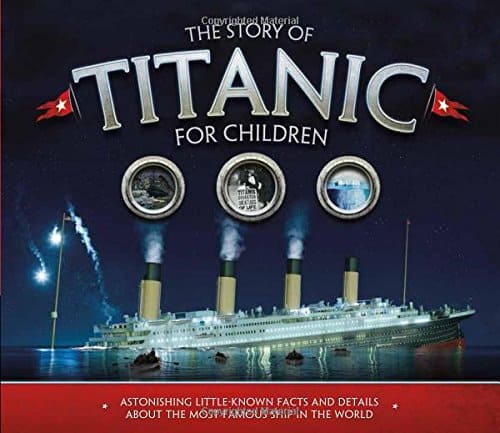
The Story of Titanic For Children:
Astonishing Little-Known Facts and Details About the Most Famous Ship in the World
By Joe Fullman
More than a century after it crashed into an iceberg, the Titanic remains as compelling as ever. Children can explore its beautiful sundecks, marvel at its design, and relive the tragic sinking of the world’s most famous ship. This insightful look at the unfolding disaster provides intriguing facts and real-life stories. 8 and up
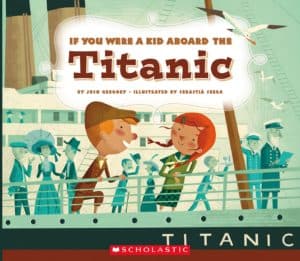
If You Were a Kid Aboard the Titanic
By Josh Gregory, Illustrated by Sebastia Serra
Alice Carver is traveling aboard the incredible Titanic with her mother to make a new home in the United States. Meanwhile, William Alexander III is aboard as part of a vacation with his wealthy family. Readers will explore the Titanic’s many features with these characters as they meet on the ill-fated ship. 7-9 years
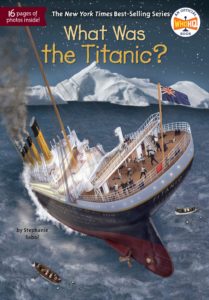
What Was the Titanic?
By Stephanie Sabol, Illustrated by Gregory Copeland
For more than 100 years, people have been captivated by the disastrous sinking of the Titanic that claimed over 1,500 lives. Young readers will find out why the great ship went down and how it was discovered seventy-five years later.
At 2:20 a.m. on April 15, 1912, the Royal Mail Steamer Titanic, the largest passenger steamship of this time, met its catastrophic end after crashing into an iceberg. Of the 2,240 passengers and crew on board, only 705 survived. More than 100 years later, today’s readers will be intrigued by the mystery that surrounds this ship that was originally labeled “unsinkable.” 8-12 years
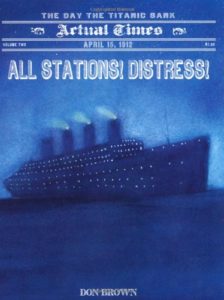
All Stations Distress! April 15, 1912: The Day the Titanic Sank
By Don Brown
It took 4,000 men to built it, 23 tons of animal grease to slide it into the ocean, 100,000 people to wave bon voyage, but only one wrong move to tear the Titanic apart. On a cold moonless night in April 1912, 2,000 passengers, the rich enjoying a luxury cruise and the poor hoping to find a new life in America, struggled to survive. Only 700 did. Lifeboats were launched half-full; women were forced to leave their husbands and sons behind; and even those who made it out alive were forever haunted, constantly wondering “why me?” 6-10 years
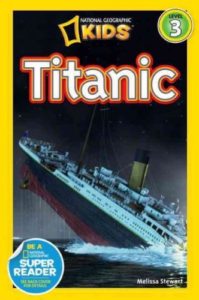
Titanic
By Melissa Stewart
For the 100th anniversary of the Olympic-class passenger liner’s ill-fated journey, this title is full of photographs and in-depth coverage including Bob Ballard’s 1985 discovery. The industrial feat of the powerful ship, the tragedy of the wreckage, and the fascinating stories of survival bring the historical significance of the Titanic to a new audience in this level 3 reader. 6-10 years

Titanic: The Story Lives On
By Laura Driscoll, Illustrated by Bob Kayganich
Discover the secrets of the Titanic 100 years after the sinking. Learn all about the search for the its wreckage in this Level 3 reader featuring photographs of the ship’s remains, as well as full-color artwork. 8-9 years
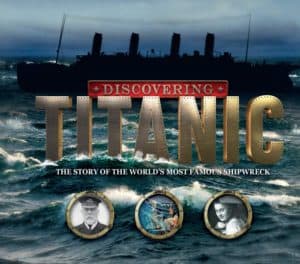
Discovering Titanic
By Ben Hubbard
Using objects recovered from the Titanic’s shipwreck, this book tells the tale of the doomed ship’s discovery, the disaster that sank her, and the human stories behind the tragedy. Focusing on Robert Ballard’s historic discovery and the expeditions that followed, this book takes children on an unforgettable journey through the remains of the sunken ship. Photography of the wreck, archival images, and modern reconstructions bring the story back to life, from the opulent liner’s construction to the night it fatally foundered. Personal artifacts recovered from the wreck introduce the passengers who sailed on this doomed voyage and offer an intimate, human view of the tragedy. 7-10 years
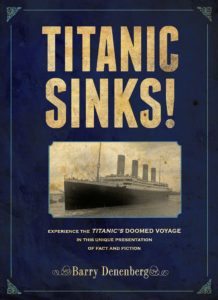
Titanic Sinks: Experience the Titanic’s Doomed Voyage in this Unique Presentation of Fact and Fiction
By Barry Denenberg
To commemorate the 100th anniversary of the sinking of the Titanic, Barry Denenberg has created high-concept book that’s a unique combination of fiction and nonfiction. He uses a fictional framework to present the true story of the building and launching of the ship and to give a “you are there” feeling as it goes down. Designed with authentic period photographs and illustrations, Titanic Sinks! immerses you in the era and tells why it’s still a cultural touchstone a hundred years after its demise. 9-12 years

882 ½ Amazing Answers to Your Questions About the Titanic
By Hugh Brewster and Laurie Coulter, Illustrated by Ken Marschall
It’s all here. The financiers and founders of the White Star Line; the building and launch; the ship’s features; the crew and passengers; the fateful collision; the scramble for lifeboats; the sinking and the survivors; the high-tech discovery of the wreck; the movie…. 882 1/2 Amazing Answers to Your Questions About the Titanic is packed with all of the intriguing details and fascinating facts that tell the true story. 8-14 years
I Survived the Sinking of the Titanic
By Lauren Tarshis, Illustrated by Haus Studio
George Calder must be the luckiest kid alive – he and his little sister, Phoebe, are sailing with their aunt on the Titanic, the greatest ship ever built. George can’t resist exploring every inch of the incredible boat, even if it gets him into trouble. But one night while George is off exploring, a terrible boom shakes the entire boat. Soon the impossible is happening: The Titanic is sinking. George has always gotten out of trouble before. Can he survive this nightmare? Graphic Novel, 8-12 years
The book descriptions used are primarily from the publishers.
If you like this post, then please consider sharing it and/or leaving a comment below. Thank you! Barbara Lowell, Children’s Author
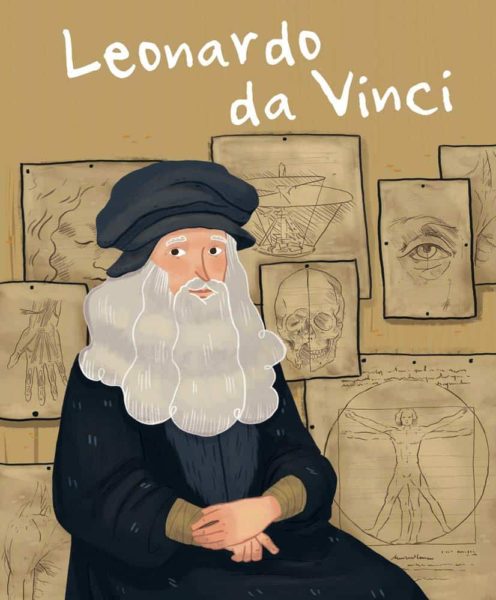
Leonardo da Vinci
By Jane Kent, Illustrated by Isabel Munoz
Why could Leonardo da Vinci paint the human form so accurately in all its beauty? How was he educated and trained as an artist? What inspired his most famous works, including The Last Supper and the Mona Lisa? And what fun machine did he invent? Find out about this unique artist and the many areas, from architecture to flight, he drew on and influenced.

Leonardo Beautiful Dreamer
By Robert Byrd
Famous in his time as a painter, prankster, and philosopher, Leonardo da Vinci was also a musician, sculptor, and engineer for dukes, popes, and kings. What remains of his work, from futuristic designs and scientific inquiry to artwork of ethereal beauty, reveals the ambitious, unpredictable brilliance of a visionary, and a timeless dreamer.
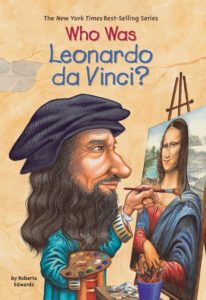
Who Was Leonardo da Vinci
By Roberta Edwards, Illustrated by True Kelley
Leonardo was a gifted painter, talented musician, and dedicated scientist and inventor. He designed flying machines, submarines and even helicopters. Yet, he had a hard time finishing things, a problem anyone can relate to. Only thirteen paintings are known to be his. As for the illustrated encyclopedia he intended to create, all that he left were thousands of disorganized notebook pages. Here is an accessible portrait of a fascinating man who lived at a fascinating time—Italy during the Renaissance.

The Science and Technology of Leonardo da Vinci
By Elizabeth Pagel-Hogan, Illustrated by Micah Rauch
During the Renaissance, inventors and other creative thinkers designed and constructed many new things. It was a time of discovery, wonder, and exploration. And one of the people on the forefront of that awakening was Leonardo da Vinci. Readers explore the life of one of the world’s most amazing minds. They discover what it might have been like to live in the fourteenth century, when work, entertainment, medicine, travel, and food were very different. They ponder the same kinds of questions that drove Leonardo to tinker and experiment endlessly, even while creating artwork that influenced entire generations who came after him. What is the inside of the body like? How might humans fly? How can geometry be used to design stronger buildings?
His dedication to invention, experimentation, and art, along with his insatiable curiosity, gave the world new insight into anatomy, botany, engineering, and much more. Kids gain these same insights through hands-on STEM activities, essential questions, text-to-world connections, and links to online resources, including primary sources, that encourage readers to take a closer look at the world of the Renaissance.
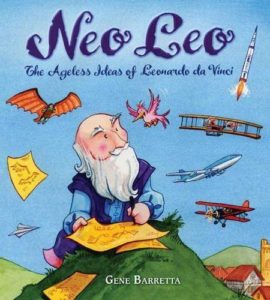
Neo Leo: The Ageless Ideas of Leonardo da Vinci
By Gene Barretta
In 1781, Thomas Paine came up with a model for a single-span bridge; in 1887, Adolf Eugen Fick made the first pair of contact lenses; and in 1907, Paul Cornu built the first helicopter. But Leonardo da Vinci thought of all these ideas more than five hundred years ago!
An artist, inventor, engineer, and scientist, he wrote and drew detailed descriptions of what would later become hang gliders, automobiles, robots, and much more. Gene Barretta cleverly shows how Leonardo’s ideas, many inspired by his love of nature, foreshadowed modern inventions and offered a window into the future.

I am Leonardo da Vinci
By Brad Meltzer, Illustrated by Christopher Eliopoulos
This book features Leonardo da Vinci, the Renaissance artist and inventor. He always followed his interests, no matter where they led! His quest to fly led him to study birds’ wings and his invention designs were the very earliest sketches of helicopters and other flying machines. His hard work and dedication to his curiosities is why we still remember him today.
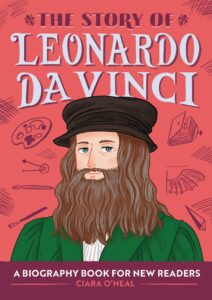
The Story of Leonardo da Vinci
By Ciari O’Neal
Leonardo da Vinci was a famous artist and thinker. He created well-known paintings like the Mona Lisa and The Last Supper, and even had ideas for modern-day inventions like cars and contact lenses. Before he amazed the world with his creative mind, he was a bright kid who loved asking questions.
As a teenager, he studied under an expert artist who taught him different ways to create, like painting and sculpting. Explore how Leonardo went from being a thoughtful young boy to an artistic genius whose artwork still hangs in museums all over the world.
The Story includes:
Core curriculum standards―Learn the Who, What, Where, When, Why, and How of Leonardo’s life, and test your knowledge with a fun quiz.
His lasting legacy―Discover more about how Leonardo da Vinci changed the world for future generations, including you!
A visual timeline―Explore a timeline marking the major milestones of his life so you can watch him progress from a little kid to a brilliant artist.
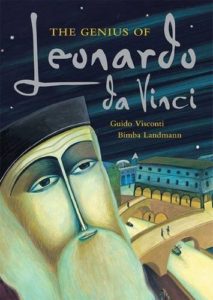
The Genius of Leonardo Da Vinci
By Guido Visconti, Illustrated by Bimba Landmann
Artist, engineer, pacifist, inventor: Leonardo da Vinci was a genius of a very particular kind. This introduction to his life and work is vividly retold through the eyes of his young apprentice, Giacomo, making it easy for young readers to relate to his story.

Leonardo da Vinci: Extraordinary Machines
By David Hawcock
The most significant creations of the Renaissance genius, Leonardo da Vinci, come to life in the pages of this illustrated pop-up book. Published to commemorate the 500th anniversary of his death, this book reveals the intricacy and importance of his designs for robots, flying machines, and other timeless inventions. The 3-D models are based on the master’s actual drawings and are accompanied by his notes.
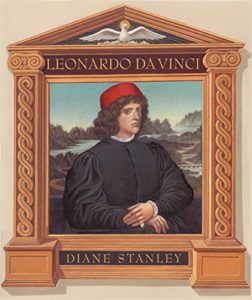
Leonardo da Vinci
By Diane Stanley
Born in 1452, to a peasant woman and a country gentleman, Leonardo da Vinci was one of the most amazing people who ever lived. He grew up to be a great painter, sculptor, architect, scientist, and inventor.
As a boy, he was apprenticed to a famous artist. But he quickly became more skilled than his teacher. He filled thousands of pages with plans for incredible inventions including a submarine, and air-cooling system, “glasses to see the moon large,” and even a flying machine.
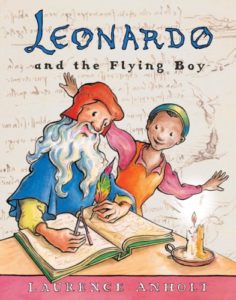
Leonardo and the Flying Boy
By Laurence Anholt
Zoro is a little boy in 17th-century Italy, long before airplanes flew in the sky. But Zoro is also an apprentice to the artist and inventor Leonardo da Vinci–and Leonardo is experimenting with a revolutionary flying machine!

Leonardo da Vinci for Kids: His Life and Ideas, 21 Activities
By Joan Herbert
The marriage of art and science is celebrated in this activity book. Kids will begin to understand the important discoveries that da Vinci made through inspiring activities like determining the launch angle of a catapult, sketching birds and other animals, creating a map, learning to look at a painting, and much more. Includes a glossary, bibliography, listing of pertinent museums and websites, a timeline, and many interesting sidebars.

Leonardo Da Vinci
By Mike Venezia
Clever illustrations and story lines, together with full-color reproductions of actual paintings, give children a light yet realistic overview of Leonardo DaVinci’s life and style.
The book descriptions are primarily from the publishers.
If you like this post, then please consider sharing it and/or leaving a comment below. Thank you! Barbara Lowell, Children’s Author






















































































